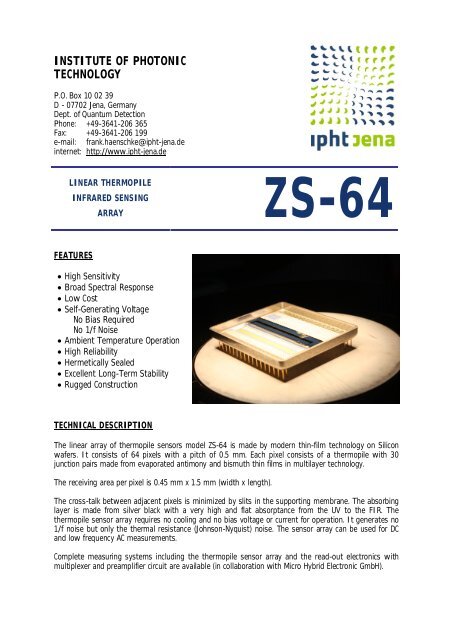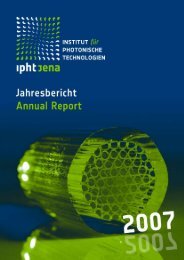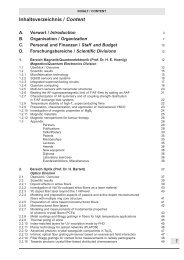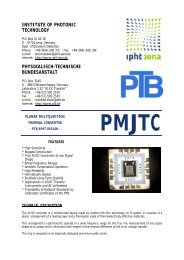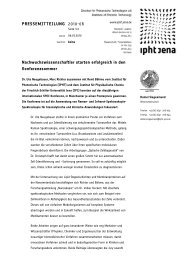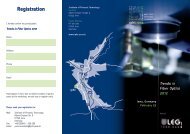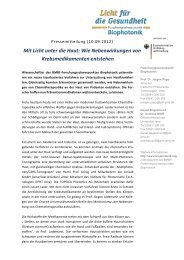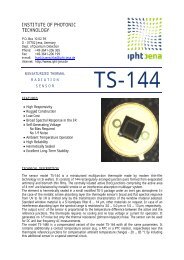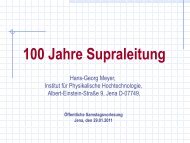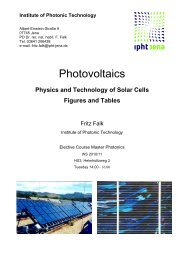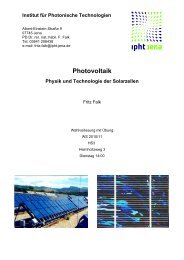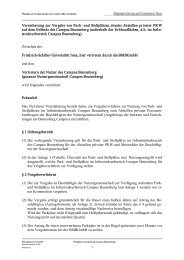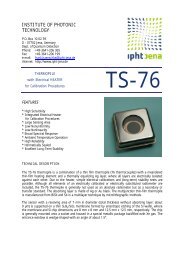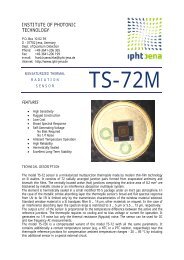INSTITUTE OF PHOTONIC TECHNOLOGY - IPHT Jena
INSTITUTE OF PHOTONIC TECHNOLOGY - IPHT Jena
INSTITUTE OF PHOTONIC TECHNOLOGY - IPHT Jena
You also want an ePaper? Increase the reach of your titles
YUMPU automatically turns print PDFs into web optimized ePapers that Google loves.
<strong>INSTITUTE</strong> <strong>OF</strong> <strong>PHOTONIC</strong><br />
<strong>TECHNOLOGY</strong><br />
P.O. Box 10 02 39<br />
D - 07702 <strong>Jena</strong>, Germany<br />
Dept. of Quantum Detection<br />
Phone: +49-3641-206 365<br />
Fax: +49-3641-206 199<br />
e-mail: frank.haenschke@ipht-jena.de<br />
internet: http://www.ipht-jena.de<br />
LINEAR THERMOPILE<br />
INFRARED SENSING<br />
FEATURES<br />
ARRAY ZS-64<br />
� High Sensitivity<br />
� Broad Spectral Response<br />
� Low Cost<br />
� Self-Generating Voltage<br />
No Bias Required<br />
No 1/f Noise<br />
� Ambient Temperature Operation<br />
� High Reliability<br />
� Hermetically Sealed<br />
� Excellent Long-Term Stability<br />
� Rugged Construction<br />
TECHNICAL DESCRIPTION<br />
The linear array of thermopile sensors model ZS-64 is made by modern thin-film technology on Silicon<br />
wafers. It consists of 64 pixels with a pitch of 0.5 mm. Each pixel consists of a thermopile with 30<br />
junction pairs made from evaporated antimony and bismuth thin films in multilayer technology.<br />
The receiving area per pixel is 0.45 mm x 1.5 mm (width x length).<br />
The cross-talk between adjacent pixels is minimized by slits in the supporting membrane. The absorbing<br />
layer is made from silver black with a very high and flat absorptance from the UV to the FIR. The<br />
thermopile sensor array requires no cooling and no bias voltage or current for operation. It generates no<br />
1/f noise but only the thermal resistance (Johnson-Nyquist) noise. The sensor array can be used for DC<br />
and low frequency AC measurements.<br />
Complete measuring systems including the thermopile sensor array and the read-out electronics with<br />
multiplexer and preamplifier circuit are available (in collaboration with Micro Hybrid Electronic GmbH).
TYPICAL SPECIFICATIONS ZS-64<br />
This data sheet may be modified at any time ZS-64_2011-10-28.DOC<br />
Active Area mm 2 0.675 mm 2 (0.45 mm x 1.5 mm) 1)<br />
Pixel Pitch mm 0.5<br />
Number of Junctions 30 1)<br />
Resistance k� 8.5 ± 3.5 1)<br />
Resistance TC %/K - 0.02 ... - 0.04<br />
Noise Voltage nV/Hz 1/2 � 12 1)<br />
Filling Gas Vacuum 2)<br />
DC Responsivity V/W 250 3) Vacuum<br />
Responsivity TC %/K -0.35...-0.55<br />
DC Output@38 µW/mm 2 mV 6,3 3) 4) Vacuum<br />
D* (500 K, DC) cmHz 1/2 /W<br />
9 3)<br />
1.6 x 10<br />
1)<br />
per Pixel<br />
3)<br />
without window<br />
2)<br />
other filling gases : Xe,<br />
4)<br />
500K<br />
Spectral Response Flat from UV to IR<br />
(dependent on Window Material)<br />
Window Materials Standard: KRS-5; 8 ... 14 µm Filter<br />
Other Materials on Request<br />
Case Metallic PDS-32<br />
Operating Temperature - 20 ... + 85 °C<br />
Weight (Chip) 2 g<br />
APPLICATIONS<br />
- Non-Contact Temperature Measurements<br />
- Spectroscopy<br />
- Position Identification<br />
Spectral absorptance of the Agblack<br />
with an interference<br />
absorbing layer in the spectral<br />
range 2 ... 14 µm


